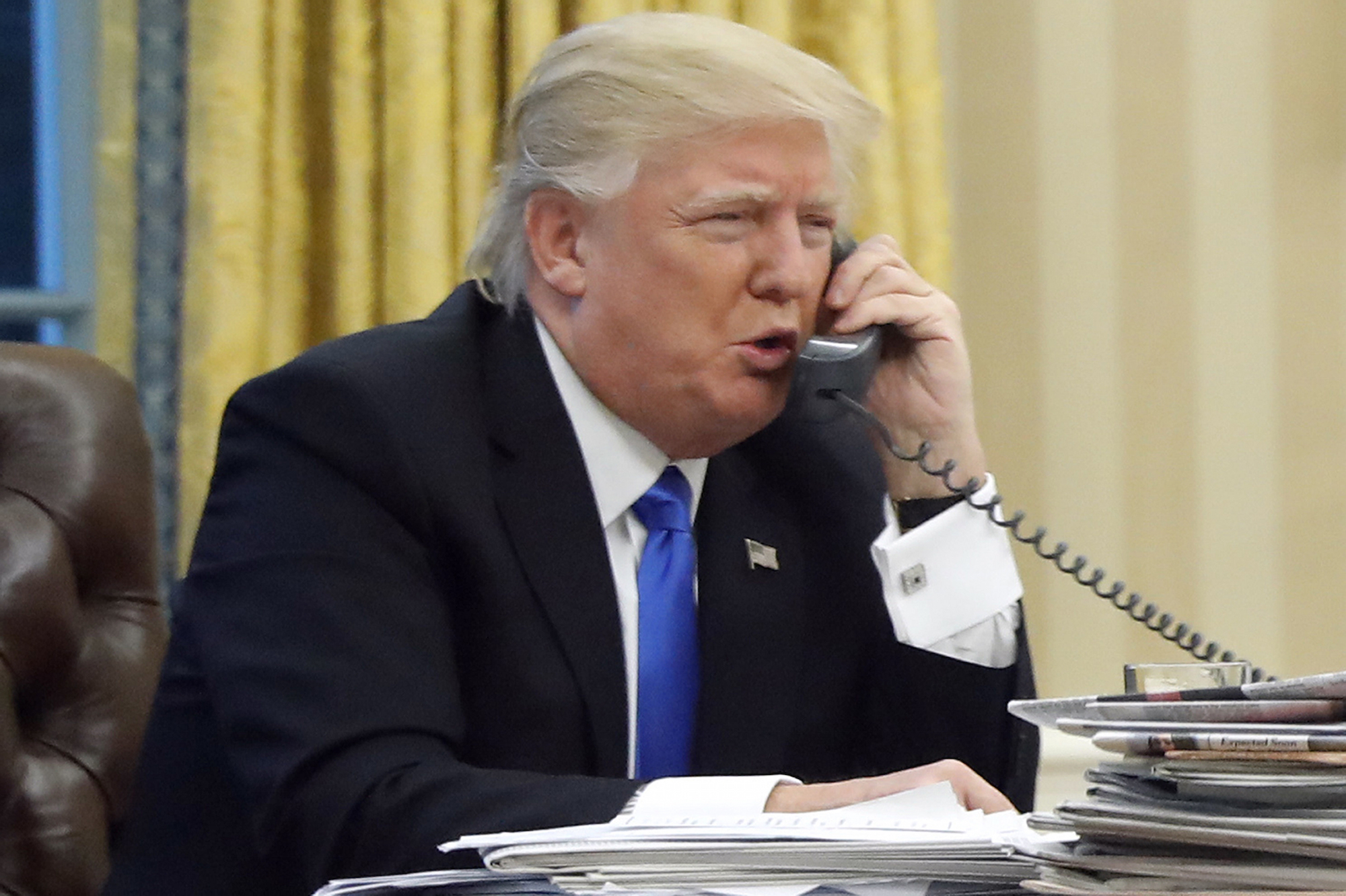A group of roughly 50 refugees formerly held in Australian-run detention centers on two Pacific islands have reportedly departed for the United States, in a major step to fulfill what President Donald Trump once called the “worst deal ever.”
The group is the first of 1,250 refugees ultimately expected to resettle in the United States, as part of an agreement with the Australian government the Obama administration brokered. In exchange, Australia is accepting refugees held in US-run detention centers in central America.
Up to 25 men left a facility on Manus Island earlier this week, and another group of 27 men and women left a second facility on the island of Nauru on Wednesday, NPR reported on Thursday.
The refugees who will soon arrive in the US are originally from Bangladesh, Iran, Sri Lanka, Somalia, and Myanmar, Australia’s Refugee Action Coalition said in a statement. They will be resettled across the US, in states including Arizona, Texas, California, Oregon, and New York.
Trump had raged about the deal to Australian Prime Minister Malcolm Turnbull in a now-infamous phone call that took place in January. The transcripts of the call were published by The Washington Post in August, and revealed a heated back-and-forth exchange in which Turnbull attempted to correct several points about the deal Trump appeared to have misunderstood or was unfamiliar with.
Trump complained about the deal and criticized the Australian leader throughout the conversation, at one point saying "I hate taking these people" and insulting Turnbull for brokering "many a stupid deal in business."
Trump eventually declared the conversation his "most unpleasant call all day" after a "pleasant" one with Russian President Vladimir Putin earlier, then hung up after dismissing Turnbull's request to discuss Syria and North Korea.
"This shows me to be a dope. I am not like this, but if I have to do it, I will do it but I do not like this at all. I will be honest with you," Trump said. "I think it is ridiculous and Obama should have never signed it. The only reason I will take them is because I have to honor a deal signed by my predecessor and it was a rotten deal."
Here's everything you need to know about the deal:
What the refugee deal is

In November 2016, the Australian government announced it had reached an agreement with the Obama administration for the US to resettle refugees held in detention facilities on two islands far from the Australian mainland: Nauru and Manus Island.
The Australian government didn't initially specify the exact number of refugees, but in the transcript of Turnbull and Trump's call, Turnbull clarified it was 1,250. The number of refugees being exchanged was a point of contention during the conversation, as Trump repeated several times the number was 2,000 or 5,000.
"With great respect, that is not right - it is not 2,000," Turnbull responded. "The given number in the agreement is 1,250 and it is entirely a matter of your vetting."
Another disagreement between the pair was the nationality of the refugees - the call took place shortly after Trump had signed an executive order banning travelers from seven countries, including Iraq, Iran, Syria, Yemen, Sudan, Somalia, and Libya.
The nationalities of the refugees at stake in the US-Australia deal are unclear, but refugee advocates say many who are detained on Manus Island and Nauru are from Iraq, Iran, Somalia, and Sudan - countries listed on Trump's original travel ban - as well as Afghanistan, and Pakistan. Some of the refugees are also stateless.
During the call, Turnbull attempted to convince Trump that the deal was "absolutely consistent" with the travel ban, meaning that the US can choose which refugees to accept and subject each of them to any security screening necessary.
"None of these people are from the conflict zone. They are basically economic refugees from Iran, Pakistan, and Afghanistan," Turnbull said.
Another point Turnbull attempted to explain was that the refugee deal was not a one-sided affair. Just two months before the deal was struck, the Australian government announced it would take in asylum-seekers from US-backed detention facilities in Costa Rica.
While the agreement is not explicitly a quid pro quo arrangement, the two deals ensure the countries are essentially swapping refugees with one another, with each country relieving the other of the responsibility of detaining asylum-seekers.
Why Australia won't just resettle the refugees on its mainland

Trump asked Turnbull several times in the call to explain why Australia couldn't take the refugees, wondering, "Why haven't you let them out? Why have you not let them into your society?"
But as Turnbull explained, his government has been ironclad in its opposition to resettling the refugees detained on Nauru and Manus islands, arguing that the issue is one of border security.
"It is not because they are bad people. It is because in order to stop people smugglers, we had to deprive them of the product," Turnbull said. "So we said if you try to come to Australia by boat, even if we think you are the best person in the world, even if you are a Nobel Prize-winning genius, we will not let you in."
At first, Trump appeared to understand, saying, "That is a good idea. We should do that too. You are worse than I am," but later asked Turnbull to explain the point again. "What is the thing with boats? Why do you discriminate against boats?"
It should be noted that Australia does take in refugees - the country recently pledged to up its annual refugee intake to 19,000 from 13,750 in 2015-16 - but the difference is that most of those arrivals are resettled through the UN's refugee agency. They arrive in Australia legally, whereas those who travel by boat do so illegally.
Australia is loath to accept the boat-borne arrivals, on grounds that successful asylum-seekers who make the journey by boat will embolden others to attempt the same and, as Turnbull explained to Trump, enable human smuggling.
In fact, Turnbull is so opposed to allowing the refugees detained on Nauru and Manus to enter Australia that his administration refused to entertain an offer from New Zealand to resettle 150 of those refugees per year. The line of reasoning was that should those refugees eventually gain New Zealand citizenship, they would also gain travel rights to Australia.
"It's a back-door way to get into Australia, and would have been a green light to people smugglers," Australia's immigration minister, Peter Dutton, told media in April.
Even when Australia announced the refugee deal with the US, Turnbull took pains to describe the situation as a "one-off agreement" that would not be offered to future asylum-seekers attempting the journey to Australia by sea.
"We need to send, now more than ever, the clearest and most unequivocal message to people smugglers and their would-be passengers that, if they seek to come to Australia unlawfully, they will not succeed," Turnbull said at a November press conference announcing the deal.
Turnbull even announced a so-called "ring of steel" to enforce Australia's border in preparation for the deal, lest the news encourage a wave of asylum-seekers to attempt to travel to Australia by sea in the hopes that they, too, could resettle in the US.
The government launched "the largest and most capable maritime surveillance and response fleet Australia has ever deployed," specifically to intercept boats of asylum seekers and turn them away from the country.
Why the international community dislikes it

Australia has long been criticized by countries around the world - including the US - for its practice of turning back asylum boats, implementing mandatory detention policies, and transferring refugees to other countries.
The average amount of time refugees are held in the detention facilities is 469 days, and nearly one-third of those detained have been held for more than two years, according to data from the Australian government.
Beyond that, the offshore detention centers have become infamous for reports of human-rights abuses and violence against detainees, many of whom are children.
Humanitarian workers who have visited the detention centers on the Nauru and Manus islands allege that instances of violence, sexual assault, and degrading treatment are commonplace, and many refugees and asylum-seekers suffer severe mental-health problems due to their prolonged detention and uncertainty for their future.
Even North Korea, The Guardian reported, slammed Australia at a United Nations council session in 2015, saying it had "serious concerns" about reports of human rights violations at the facilities.
The deal for the US to resettle the refugees has therefore come under some scrutiny, as it essentially legitimizes Australia's practice of intercepting asylum seekers and detaining them instead of forcing the country to change its policies.
The US agreement to resettle the refugees has been given the blessing of the United Nations High Commissioner for Refugees (UNHCR), the UN's refugee agency, which will help the two countries in the resettlement process - but, like the US-Australia deal, it's a one-off arrangement that likely won't be repeated.
The UNHCR maintains that Australia's policy of detaining asylum-seekers offshore is illegal.
"We, all of us, are very clear that this is a one-off, good offices, exceptional humanitarian type of involvement because we do not believe that the future of handling this lies in sending people to Manus Island and Nauru," Volter Turk, assistant high commissioner with the UNHCR, told The New York Times in November 2016.
What's next

Australians have been wondering about the future of the deal since the moment Turnbull announced it, as it's no secret that Trump has wanted to dramatically reduce the number of refugees the US accepts.
Shortly after the phone call between Trump and Turnbull in January, the White House confirmed it planned to honor the deal and apply "extreme vetting" to all the arrivals. Indeed, the initial executive order Trump signed barring all refugees for 120 days included an exception for preexisting international agreements, widely presumed to refer to the deal with Australia.
But Reuters later reported that US immigration officials cut short their screening interviews on Nauru two weeks early, just after the White House announced the US had reached its annual refugee intake cap. US Citizenship and Immigration Services declined to discuss exact dates, but told the news agency it was planning return trips.
Turnbull said last Wednesday that "vetting and processing by the United States will continue, and further decisions by US authorities in respect of others are expected in due course," The New York Times reported.
Although the news of the first group of refugees departing for the US is a step toward fulfilling the agreement, refugee advocates have expressed concern about the slow pace of resettlement. US officials first interviewed the group that left Nauru and Manus this week 10 months ago, according to Refugee Action Coalition.
"There are more than 1,700 refugees, including around 150 Rohingyan refugees, on Manus and Nauru who desperately need safety and protection now," the group's spokesperson, Ian Rintoul, said in a statement.
"The refugees were bluntly told by the US officials that there is no date for more refugees to fly to the US, and that some people will not be accepted."

